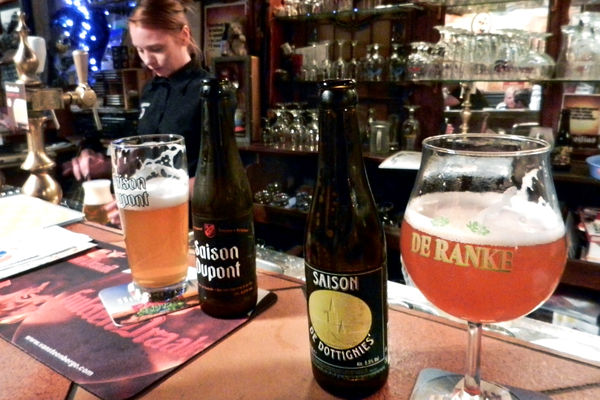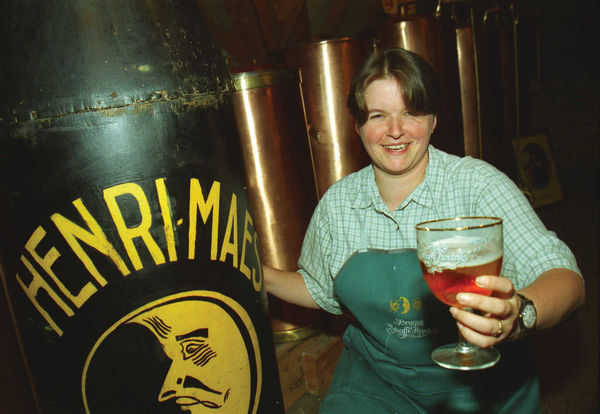Belgian Beer Basics


By Rick Steves, Gene Openshaw, and Dave Hoerlein
The traveler faces a wonderful dilemma when perusing a Belgian beer menu: Though only around the size of Maryland, Belgium produces about 120 varieties of beer and 580 brands — more than any other country. Even small café menus include six to eight varieties. Connoisseurs and novices alike can be confused by the many choices, and casual drinkers probably won't like every kind offered, since some varieties don't even taste like beer. Belgian beer is generally yeastier, sweeter, less bitter, and higher in alcohol content than beers in other countries.
Belgians take their beers as seriously as the French do their wines. You'll find beers corked and wired like a bottle of Champagne, and some beers will mature in the bottle up to six years. Belgians even pair beer with food, much as the French pair wine. In general, lighter-colored beers (blonde or Tripel) go well with chicken or pork; darker beers pair nicely with beef; and wheat beers complement seafood.
To bring out their flavor, different beers are served cold, cool, or at room temperature, and each has its own distinctive glass. Whether wide-mouthed, tall, or fluted, with or without a stem, tulip-shaped or straight, the glass is meant to highlight a particular beer's qualities. The choice of glass is so important that if, for some reason, a pub doesn't have the proper glass for a particular beer, they will ask the customer if a different glass will be acceptable — or if they'd like to change their beer order.
To get a basic draft beer in Flanders (Bruges, Antwerp, Ghent), ask for een pintje (ayn pinch-ya; a pint); in Brussels and other areas where French prevails, request une bière (oon bee-yair).
But don't insist on beer from the tap. The only way to offer so many excellent beers and keep them fresh is to serve them bottled. In fact, because many specialty beers ferment in the bottle, some of the most famous brews come only in bottles. Increasingly, though, bars are adding a few high-end brands to their draft menus.
Specialty Beers
Despite its reputation for excellence, Belgium beer is still not well known in the US. Its small but growing export market is hampered by the fact that some varieties don't travel well, and many are made in small quantities. Connoisseurs avoid the mass-produced labels (Leffe, Stella, and Hoegaarden — all owned by AB InBev, which owns Budweiser in America).
Specialty beers can be much more alcoholic than what you're used to back home, and tourists often find themselves overwhelmed by a single pint of Belgian brew. Bottles (and often menus) list the alcohol percentage of each type of beer. For comparison, most mass-market American beers are 4–6 percent alcohol by volume, while a heavy Belgian ale can run to 7–9 percent — and a few powerful beers can be 10–12 percent or even higher.
Monk-run Trappist breweries have given the beer world the terms Enkel, Dubbel, and Tripel (single, double, triple). While originally these indicated the amount of malt used to gain a higher alcohol content, these days they have more to do with the style of beer: Enkel is a very light (nearly "lite") blonde ale; Dubbel is a dark, sweet beer; and Tripel is a very strong, golden-colored pale ale. The less commonly used term Quadrupel is a gimmick to emphasize a beer's alcohol content — usually more than 10 percent.
Some beer producers have returned to their medieval roots, flavoring their beer with a secret mix of spices called gruit. This can result in some surprising bouquets that charm and puzzle beer aficionados.
Beers by Type
Many beers don't fall neatly into these categories, but here's a rough overview of Belgium's bevy of beers.
Ales (Blonde/Red/Amber/Brown): Easily recognized by their color. Try a blonde or golden ale (Leffe Blonde, Duvel), a rare and bitter sour red (Rodenbach — its maroon color comes from two years spent in an oak cask), an amber (Palm, De Koninck), or a brown (Leffe Bruin). Kwak, an amber ale named for a 19th-century innkeeper, is served in a unique hourglass-shaped glass that's reason enough to place an order. Saison beers are "seasonal" (summer-brewed), lightly alcoholic pale ales.
Lagers (Pils): Light, sparkling, Budweiser-type beers. Popular brands include Jupiler, Stella Artois, and Maes.
Lambics: Wild-yeast beers. Lambics — popular in Brussels — get their start in open vats, where they're exposed to naturally occurring wild yeasts in the air. Some undergo a "double fermentation" in the bottle, giving these lambics a bubbly sparkle and a flavor often described "cidery." Some brand names include Cantillon, Lindemans, and Mort-Subite ("Sudden Death").
Lambics are often blended with fruits to counter their sour flavor. Fruit lambics include sour cherry (kriek), raspberry (frambozen), peach (pêche), or blackcurrant (cassis). People who don't usually enjoy beer tend to like these tart but sweet varieties, similar to a dry pink champagne. (Whereas detractors claim that they taste like a perfectly decent beer mixed with cough syrup.) Gueuze — a dry, sour, double-fermented lambic nicknamed "Brussels champagne" — is definitely an acquired taste.
White (Witte or Witbier): Milky-yellow summertime beers made from wheat. White beer, similar to a Hefeweizen, is often flavored with spices such as orange peel or coriander.
Trappist and Abbey Beers: Heavily fermented, malty, monk-brewed beers. For centuries, between their vespers and matins, Trappist monks have been brewing beer. Three typical ones are Tripel, with a blonde color, served cold with a frothy head (and in the traditional chalice-shaped glass); Dubbel, dark, sweet, and served cool; and Enkel, made especially by the monks for the monks, and considered a fair trade for a life of celibacy. These styles originated at the Westmalle monastery; other official Belgian Trappist monasteries are Rochefort, Chimay, Orval, Achel, and Westvleteren (the last one's brews are often voted the "best in the world" and are hard to find). "Abbey beers" (abdijbier) emulate the Trappist style but are produced at other monasteries or by commercial brewers; St. Bernardus is one popular abbey beer. Try the Trappist Chimay Blauw/Bleu — extremely smooth, milkshake-like, and complex.
Strong Beers: The potent brands include Duvel ("devil," because of its high octane, camouflaged by a pale color), Verboten Vrucht ("forbidden fruit," with Adam and Eve on the label), and the not-for-the-fainthearted brands of Judas, Satan, and Lucifer. Gouden Carolus is good…and Delerium Tremens speaks for itself.
Santé and gezondheid! (Cheers!)
Gene Openshaw is the co-author of the Rick Steves Belgium guidebook. Dave Hoerlein is a veteran Rick Steves guidebook cartographer, tour guide, and travel consultant.

